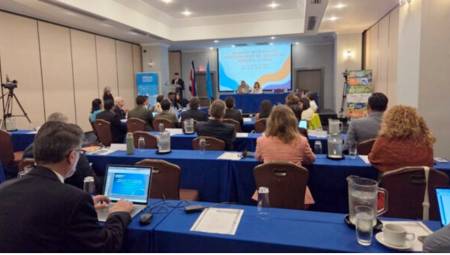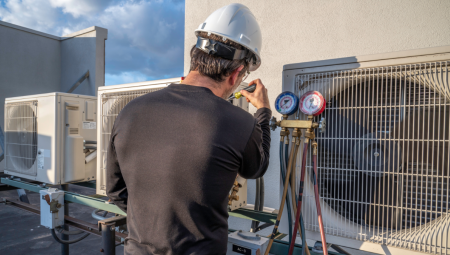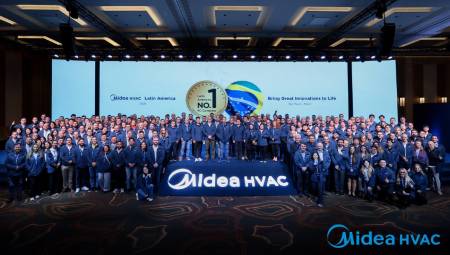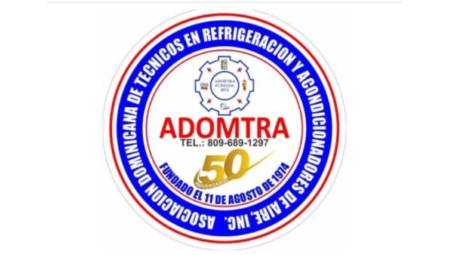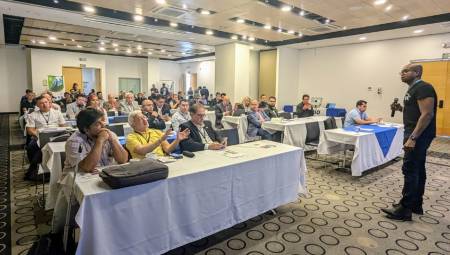by: IIR*
Magnetic cooling is an adiabatic cooling method that applies the magneto-caloric effect (EMC). From the point of view of basic physics, it shows an analogy with the conventional method of gas compression/expansion. It has been applied for many years in cryogenics to reach very low temperatures.
In 1976, Brown introduced the first room temperature cooler that applied adiabatic magnetization and demagnetization1. After the discovery of the "giant" magneto-caloric effect (EMCG) in Gd5 (Si2Ge2) in 1997 by Gschneidner and Pecharsky2 that increases the EMC, many scientists and industry representatives accept that this "new" technology has a good potential to have in the future a great penetration in the refrigeration market; are convinced that in different areas conventional cooling could be replaced by magnetic.
The main reason for this attitude is the possibility of replacing HFC refrigerants with environmentally benign magneto-caloric alloys. HFCs with a global warming potential (GWP) of 1000 to 3000 times greater than that of CO2, currently show a growing sales market, which has its origin in the progressive elimination of the most destructive HCFCs and CFCs. This process is still in progress and in most developing countries HCFCs and CFCs are still allowed. Systems with natural refrigerants (ammonia, CO2, propane, etc.) are good solutions for different applications, but to date, none of them have made remarkable progress on a wide scale of applications. Other advantages include the higher cycle efficiencies of magnetic cooling processes, compared to those of gas compression cooling and the noise-free operating conditions of a magnetic cooler. This IIR briefing note briefly highlights the latest developments, advantages and disadvantages of this promising technology.
Begin with
The refrigeration technology market is closely related to the production of beverages and food, the industrial process, the chemical and pharmaceutical industry in addition to the automotive sector. Some of these niches are developing strongly, thanks to growing revenues from customers in Eastern Europe, India and China. The retail market, supermarkets and hypermarket chains are benefiting greatly from this development.
Because the number of alternative cooling technologies that have been built is negligible, positive prospects have been created for producers of gas compression systems.
In addition, the trend toward cooling local buildings in southern areas is also increasing. The scenario (as commercial as ever), based on simulations of dynamical, numerical and climatological systems, was published by the European Commission. The prediction for 2010 is for an HFC emission level equivalent to 66 tons ofCO2; representing an increase of 62 per cent over the 1995 value. Cooling and air conditioning are responsible for 43%. What will be the alternatives when HFCs also have to be reduced? That is the desire of a growing number of politicians in some countries.
Perhaps new refrigerants that are less harmful will be discovered. A new blend has just been developed and announced by an industrial company, but so far, reliable experiences are lacking. For that reason, the time would be ideal for an alternative cooling technology, such as magnetic.
This promising technology works without gaseous refrigerant and its energy efficiency (coefficient of performance), in principle, can be higher than that of a conventional refrigeration system. As a result, their progress in certain market domains would lead to lower CO2 production in the atmosphere. This briefing note provides an overview of the technology, discusses ideal and not-so-promising applications, and reports on some issues that need to be fixed to enter the industrializing phases for the different imagined refrigeration applications. {mospagebreak}
The magneto-caloric effect
A magneto-caloric material can offer three different contributions to total entropy: a magnetic contribution, an electronic one, and a networked contribution3. Entropy is a measure of order in the magneto-thermodynamic system. A high order is related to a low entropy and vice versa. Dipoles, i.e. electron rotations can show different orientations. If it is a paramagnet, a ferromagnet or a diamagnet, these entities are oriented in the same direction, the order and also the magnetization are high.
It is clear that the application of a magnetic field aligns the electronic rotations, and the decrease in temperature (releasing energy from the system) also leads to a more orderly system. Therefore, in the sense of the theory of critical phenomena, the external magnetic field produces the stress parameter and magnetization the order parameter of such materials. In Figure 1, the magnetization of pure gadolinium is shown as a function of the "magnetic field" ??? 0H and temperature T. If all moments or rotations are aligned, the maximum magnetization Mmax is presented. The actual magnetization M(T,H) is divided by this maximum value Mmax = 2.47 T (tesla) to obtain the normalized magnetization mˆ = M/Mmax.
The temperature is also normalized; is divided by the Curie Tc temperature of the material: t = T/Tc. For gadolinium, the Curie temperature is simply at room temperature, i.e. at Tc ? ?293 K. The maximum magnetization (mˆ ?1) occurs at the absolute zero point (T = 0 K or t = 0), regardless of the applied magnetic field. At higher temperatures, the magnetization is lower. In addition, here one can observe a dependence on magnetic field. It is clear that a larger field produces a greater ordering, respectively a greater magnetization mˆ.
If the magneto-caloric material is brought into a magnetic field, this usually involves a rapid process. Virtually no heat will be exchanged with the environment. So, for this adiabatic process, the total entropy "s" (which in normal cases is the sum of magnetic sM, electronic sE and sL of network entropy) remains constant: s = sM + sE + sL = const.3 but magnetization increases. This means that the magnetic entropy sM decreases. Therefore, the remaining electronic and network entropies (sE and sL) must increase. Through rotational network couplings (which are presented in milliseconds), phonons or network vibrations are created. These oscillatory motions can be compared to the Brownian motion of atoms or molecules in a gas.
These increase the temperature of the solid material. It is now clear that the removal of the magneto-caloric material from the magnetic field decreases its lattice vibrations and temperature, because at this instant the magnetic moments and rotations take energy from the lattice and become disordered again. Achievable temperature increases ?? of gadolinium for the changes of the "magnetic field" ?0H of T 1 and 2 are shown in Figure 2. For both field changes, the decrease in temperature occurs at the highest temperature ? + ??, with the same absolute value of the temperature change, ? ?? ?, in the case of heating and cooling8.
For the magnetic cooler with permanent magnets of reasonable weight, T2 is at the moment the maximum obtainable force of "magnetic field". For the magnetic field, the process described is a second-order phase transition. For larger magnetic fields, this transition becomes continuous. The exchange of degrees of release described between the magnetic momentum/rotation and the lattice system is the key process for magnetic cooling and was discovered in 1881 by the German physicist Emil Warburg.
Magnetic cooling processes
Figure 3 shows the four basic steps of a conventional gas compression/expansion cooling process. The steps are: compression of a gas, heat extraction, gas expansion and heat injection. The two steps of the process called heat extraction and expansion are responsible for the two-step cooling process. The main process usually occurs through gas expansion.
The steps of a magnetic cooling process are analogous. By comparing Figure 3 with Figure 4, we can see that instead of compressing a gas, a magneto-caloric material moves within a magnetic field and that, instead of expansion, it moves out of the field. As explained in the previous section, these processes change the temperature of the material and the injected heat can be extracted as it was done in the conventional process.
There are some differences between the two processes. The injection and expulsion of heat into a gaseous refrigerant is a somewhat fast process, because turbulent movement transports heat very quickly; unfortunately, this is not the case in solid magneto-caloric materials, in them the transport mechanism for heat is a slow molecular diffusion. Therefore, currently porous filigree structures are considered as the best solution to overcome this problem.
Small distances from the central regions of the material to an adjacent fluid domain, where a heat transport liquid captures heat and moves it out of the material, are ideal for making the magnetic cooling process faster. In addition, the not very large adiabatic temperature differences of magneto-caloric materials will require more frequently, than what conventional refrigerators require, a regenerative or cascade magnetic refrigerator design8 and, therefore, demand additional heat transfer steps. {mospagebreak}
Magneto-caloric materials and their properties.
To apply the magneto-caloric effect with high performance, it is necessary to have optimal properties in magnets and magneto-caloric materials. For this, the different families (which present a large GMCE) must be taken into account. Pure gadolinium can be considered as the ideal substance for magnetic cooling, as well as the ideal gas for conventional refrigeration. But just as conventional systems are usually operated with ideal gases, magnetic coolers will perform better with specially designed alloys.
An advantage of pure gadolinium is that its properties can be described by basic physical laws, such as the Brillouin function for magnetization, the Debye function for specific heat, etc. This allows the numerical calculation of high-resolution magneto-thermodynamic diagrams9. Producing such diagrams for magneto-caloric alloys would demand a tremendous amount of high-quality experimental data, which is not normally available. Therefore, it usually makes sense to start with an initial test of a prototype magnetic refrigerator with a gadolinium filler. After solving the initial problems of a new machine with the gadolinium content, the latter can be replaced by better magneto-caloric alloys. Gschneidner and Pecharsky10 have published the following list of promising categories of magneto-caloric materials for application in magnetic refrigerators:
* Binary and tertiary intermetallic compounds.
* Gadolinium-silicon-germanium compounds.
* Manganitas.
* Compounds based on lanthanum-iron.
* Manganese-antimony arsenide.
* Iron-manganese-arsenic phosphids.
* Fine and amorphous alloys (very recent).
Currently, toxic substances in such compounds are being replaced by more acceptable elements. Currently, total entropies and related cooling capacity, adiabatic temperature change, and material costs are under investigation. Brück states that in the near future, other properties such as corrosion resistance, mechanical properties, heat conductivity, electrical resistivity and environmental impact will also be important4.
Currently, the best (but not very expensive) materials are reported with cooling capabilities at a T2 "magnetic field" resistance change of approximately 1500 J/kg at constant temperature9 and an adiabatic temperature change of 7-8 K. Materials with low magnetic hysteresis are favorable because the area of a hysteresis curve over M vs. H coordinates corresponds to the energy dissipated in the environment in each cycle.
Magneto-thermodynamic machines.
Application of GMCE signals for a magnetic field change in a magneto-caloric material. This can be done using different magnetic cooling principles:
* Alternative change of magnetic fields in static blocks of magneto-caloric material by application of electro-magnets.
* Rectilinear movement of magneto-caloric material with permanent magneto assemblies.
* Rectilinear movement of permanent magneto assemblies with blocks of magneto-caloric material.
* Rotational movement of magneto-caloric material with static permanent magneto assemblies.
* Rotary movement of permanent magneto assemblies with blocks of magneto-caloric material.
The basic magneto-thermodynamic cycles are the Carnot cycle , the Brayton cycle, and the Ericsson cycle. Likewise, the regeneration and cascade processes are explained. Another concept is the application of AMR (Active Magnetic Cooling)10.
So far, studies of 28 prototypes have been published, one of the most successful machines was built by Astronautics Corporation, USA, and is shown in Figure 5. This rotary type of magnetic cooler is operated with a frequency of up to 4 Hz, possesses a magnetic field induction of 1.5 T, is filled with gadolinium spheres and has a cooling capacity of 95 W with a maximum temperature range of 20K10. Other prototypes have been built by the Institute of Material Science in Barcelona, Spain, Chubu Electric/Toshiba in Yokohama, Japan, a team from the University of Victoria, British Columbia, Canada, the Sichuan Institute of Technology, Nanjing University, Nanjing, China, the Laboratoire d'Electronique Grenoble in Grenoble, and Cooltech Applications, France11.
The prototype designed by the University of Victoria applies the layered platform technique with two different materials. By choosing different alloys in different positions in the refrigerator, the performance of the refrigerator increases. The prototype refrigerator built at the Sichuan Institute of Technology was the first to apply a material with GMCE above the adiabatic temperature difference of gadolinium. {mospagebreak}
Advantages and disadvantages
The potential advantages of magnetic cooling are valid compared to direct evaporation refrigerant machines:
* "Green" technology, without the use of conventional refrigerants.
* Noise-free technology which is an advantage in contexts such as medical applications.
* Greater energy efficiency. Thermodynamic cycles close to the Carnot process are possible due to the reversibility of the MCE.
* Simple design of the machines; for example, refrigerator with porous and rotary heat exchanger.
* Low maintenance costs.
* Low atmospheric pressure. Advantage in applications such as air conditioning and refrigeration units in automobiles.
On the other hand, there are some disadvantages:
* GMCE materials should be developed that allow higher frequencies of rotating and rectilinear magnetic coolers.
* Protection of electronic components from magnetic fields. It should be noted, however, that they are static, short-range and can be shielded.
* Permanent magnets have limited field resistance. Electromagnets and superconducting magnets are expensive.
* Temperature changes are limited. Multi-stage machines lose efficiency with thermal transfer between stages.
* The movement of the machines requires high precision to avoid a reduction of the magnetic field due to the intervals that occur between the magnets and the magneto-caloric material.
Possible future applications
The list of possible applications includes all fields of refrigeration, thermal pump technology and energy conversion. However, there are two conditions that limit the applications of the technology in its current state. The first is the temperature range; if the difference between the upper and lower temperature levels is large, then the number of stages also becomes large, and practical realization is no longer economical.
The second condition is the stability of the operating conditions; because the MCE is limited to a domain around the Curie temperature where the continuous phase transition occurs, it is difficult to operate magnetic cooling machines under highly fluctuating conditions. stable for reliable and efficient operation in a magnetic cooling system. The potential for cost-effective magneto-caloric air conditioning systems was described by Russek and Zimm in the IIR Report12.
Conclusion
Magnetic cooling is undoubtedly a promising technology that must be promoted for its many advantages, in particular in energy savings and environmental benefits. Currently, efficient prototypes for specific applications must be built in such a way that the refrigeration industry can be convinced to introduce industrializing phases for the production of new magnetic refrigerators.
*This briefing note was prepared by Peter W. Egolf, chair of the IIR magnetic cooling task force, and Ronald E. Rosenweig, formerly Chaire Blaise Pascal, Paris, and author of Ferrohydrodynamics13. In addition, it was reviewed by different IEEE and IRR experts around the world.
References
1. Brown G.V. Magnetic Heat Pumping Near Room Temperature, J. Appl. Phys. 47, 3673-3680, 1976.
2. Pecharsky V.K, Gschneidner K.A. Jr. Giant Magnetocaloric Effect in Gd5(Si2Ge2), Phys. Rev. Lett. 78 (23), 4494-4497, 1997.
3. Tishin A.M, Spichkin Y.I. The Magnetocaloric Effect and its Applications, Series in Condensed Matter Physics, Institute of Physics, Publishing Ltd, 2003.
4. Brück E. Developments in Magnetocaloric Refrigeration, Topical Review J Phys. D: Appl. Phys. 38, R381-R391, 2005.
5. Yu B.F, Gao Q, Zhang B, Meng X.Z, Chen Z. Review on Research of Room Temperature Magnetic Refrigeration, Int. J. Refrig. 26, 1-15, 2003.
6. Egolf P.W, Sari O, Kitanovski A, Gendre F. (Editors). Proc. 1st Int. Conf. magn. Refrig. Room Temp., Montreux, Switzerland, September 27-30, 2005.
7. Auracher H, Egolf P.W. (Editors). Magnetic Refrigeration at Room Temperature, Special Issue of the Int. J. Refrig. 29 (8), 2006.
8. Kitanovski A, Egolf P.W. Thermodynamics of Magnetic Refrigeration, Int. J. Refrig. 29, 3-21, 2006.
9. Rosensweig R.E, Gonin C, Kitanovski A, Egolf P.W. Magneto-thermodynamics Charts of Gadolinium for Magnetic Refrigeration (in preparation).
10. Gschneidner K.A. Jr, Pecharsky V.K, Tsokol A.O. Recent Developments in Magnetocaloric Materials, Institute of Physics Publishing, Rep. Prog. Phys. 68, 1479-1539,
2005.
11. Muller C, Vasile C. A new System for Magnetocaloric Refrigerator, Proc. 1st Int. Conf. magn. Refrig. Room Temp., Montreux, Switzerland, September 27-30, 2005.
12. Russek S.L, Zimm C.B. Potential for Cost-effective Magnetocaloric Air-conditioning Systems, Bulletin of the IIR. 2006-2, 4-17.
13. Rosensweig R.E. Ferrohydrodynamics, Cambridge University Press, New York, 1985; reprinted with updates by Dover Publications, Inc. Mineola, New York, 1997.



